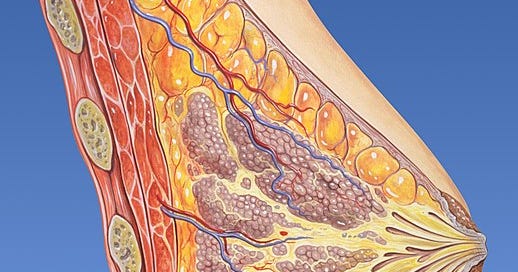The mammary gland overlies the chest wall (1) and the pectoralis muscles (2). Milk is produced in cells that line the lobules (3) and milk flows through the series of ducts (6) to the nipple (4). The lobules are interspersed and surrounded with fatty tissue (7) and covered with skin (8).
Original author: Patrick J. Lynch. Reworked by Morgoth666 to add numbered legend arrows. / CC BY (https://creativecommons.org/licenses/by/3.0)caption...
Twice a day, we children helped to milk the cows by hand. I still remember the warm, intimate smell of the cow as I settled onto the one-legged stool and rested my head in the crook of her hind leg. The strong musical resonance as the rich streams of frothy milk hit the stainless-steel milk pail lulled both milker and milked into meditation. Children were started on Ramona, a remarkably forgiving Guernsey cow who tolerated our tenuous attempts to coax milk from her very large teats. Even with her compliance, it took two small hands wrapped around one of her teats to squeeze out a respectable stream of milk. Because Ramona’s milk was exceptionally rich, her morning milk was reserved for home use. Mother transferred the frothy new milk from the tall stainless steel milk pail into clean two-quart fruit jars. She cooled the milk in the refrigerator and after an hour or two, the milk separated naturally into “top milk” and cream layered over a watery skimmed portion. The cream layer from Ramona’s milk filled almost one-half of the fruit jar. We drank the skimmed milk as a beverage and Mother reserved the top milk and cream for baking and as a topping for apple torte or fresh berries.
We humans, as well as the cows and other animals, are mammals. The word comes from the Latin word, mamma meaning breast, teat or pap. Animals of the Mammalia class nurse their young from the breast. When a newborn infant suckles at the breast, the suckling pressure causes the release of hormones from the mother’s brain. The hormones stimulate milk production and release of milk from the ducts; this process is called milk let down. Suckling, as well as the act of exerting pressure on the teat during milking, extends milk production long after the infant is weaned. Thus, animals that are raised for milk production, as indeed the human wet nurse engaged in the past by wealthy mothers, can continue to produce milk for extended periods of time, as long as the breasts are stimulated and the brain secretes the hormones required for milk release.
The term milk lines, refers to two thickened lines of tissue that are formed sometime before the mammal is born. The lines extend from the armpit to the inguinal region (groin). The milk producing organs of different mammals are located at different places along these lines (Wessel 2016). Mammary glands of humans and other primates rest on the pectoralis muscles on either side of the chest wall. Ramona and her sister cows have two pairs of teats in a specialized organ, the udder, located in the groin. Sheep, goats and horses have one pair of teats extending from the udder. Pigs, dogs and cats feed their multiple offspring litters from 8-14 nipples that arise along the length of the milk lines from groin to armpit. Why this species difference you may ask? No one knows, but a bikini would look very odd if humans had udders instead of breasts.




